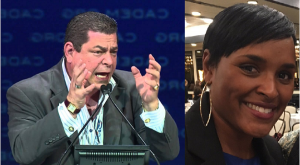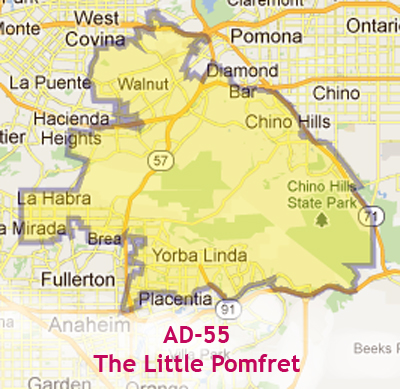.
.
.
Look below, between the two photos featuring donkeys, to get information on when individual ADEM meetings will occur!
This is OC’s ADEM weekend. Democrats (and those registering as such, for however long, at the event) at all six of the Assembly Districts falling entirely within Orange County will choose their 7 male and 7 female representatives to California Democratic Party’s (“CDP”) governing body — the Democratic State Central Committee (“DSCC”) — at the Assembly District Election Meetings (“ADEMs”). The seventh Assembly district, AD-55, is half in OC and half in LA and Chino Hills; it held its election the weekend before last. (I was among the 14 people elected there, as part of a very congenial slate that had little competition. That certain DPOC members from outside of the district reportedly came and tried to convince voters to vote for everyone on the slate but me just made it that much sweeter — but that’s a story for another time.)
Here’s a portrait of AD-55 from my “OC Constellations” series produced following the 2011 redistricting, the purpose of which was to make it easier for people to visualize and get accustomed to their new districts. Its purpose here will soon become clear.
While the AD-55 election was pretty placid, the six elections occurring this weekend — Saturday in ADs 65, 68, 73, and 74 and Sunday in ADs 69 and 72 — probably won’t be. (So OC’s dominant Regional Director Florice Hoffman will convening one meeting on Sunday — the one with a slate coming from Tom Daly and Lou Correa, — and everything else except AD-72 is happening on Saturday, suggesting that Florice will have plenty of time to be on call for situations arising in other districts.) Many districts have multiple slates as well as independents; some already have heated online battles. Collectively, they have lots of good candidates — and some middling and bad ones.
We will be devoting separate posts to each of the six districts, which will include our own recommendations and an open forum for candidates to participate by making statements and by answering questions that may be asked by our readers. Some of this exists on Facebook, but that is not as widely accessible as these pages will be.
Each page will have its own “constellation” from my series, so it should be easy for people to find. We’ll try to leave them “on the front page” until Sunday afternoon. First let’s talk about what’s been going on in the ADEMs this year and why it’s critical to the state of the party. Here, look at this picture of a stool:

Drawing & concept of making a graphic by Margot Tenenbaum; text and original “stool” metaphor from the CDP; coloring, composition, and adaptation include a second panel discussing changes in power by moi.
The stool refers to a power-sharing arrangement imposed by the CDP to divide its roughly 3,000 delegates: about 1,000 each will come from each of three groups:
- Party Leaders and Elected Officials (shown in yellow-gold in the graphic) — this includes people who were the leading vote-getters for a district even if they weren’t elected — or even if they were shut out of the November runoff
- County Central Committee Appointees (shown in orange) — in OC, enough spots usually exist for every member of the DPOC, plus some of the alternates
- Assembly District Election Meeting Winners (shown in leaf green) — who are elected by whatever Democrats show up at the meetings, and who in 2017 were dominated by mostly Berniecrats from the party’s grassroots
The underlying dynamic in the CDP right now, especially in the wake of the removal of Eric Bauman from the Chair’s position, is one in which elected officials and their sponsors are engineering a power grab to reduce the number of delegate spots available to the general public and increase the number that owe fealty to the politicians themselves and won’t get in the way of their continuing to block reforms on behalf of their big donors. That sounds harsh, so I’ll explain.
 The third-party/leftist criticism of the Democratic Party is acts towards leftist reformists like the Peanuts characters Lucy Van Pelt does to Charlie Brown: Lucy would tee up the football for Charlie — promising that this time she would not pull it away and leave him swinging his leg at empty space and falling onto his back. In other words, they say that Democrats are tricking activists into voting for them with pretty promises, but that they will always find a way to lose, even if it means “taking a fall,” and will only go through the motions of supporting reform so long as they can ensure that it won’t lead to actual reform of the sort that would piss off big donors. The argument is more progressive reform legislation was sent to the Governor’s desk during Arnold Schwarzenegger’s administration than happened in Jerry Brown’s, because they couldn’t be sure that Brown would veto it. Hence, critics say, we hear lots of talk in favor of Medicare for All, rent control, alternative energy, etc., but something — a committee chair, moderates, the Assembly Speaker or Senate Majority Leader, the Governor, the courts (due to a foreseeable design flaw), or even inexplicable baton drops — will always get in the way of actually enacting legislation, despite almost all Democrats seeming to want those popular progressive results.
The third-party/leftist criticism of the Democratic Party is acts towards leftist reformists like the Peanuts characters Lucy Van Pelt does to Charlie Brown: Lucy would tee up the football for Charlie — promising that this time she would not pull it away and leave him swinging his leg at empty space and falling onto his back. In other words, they say that Democrats are tricking activists into voting for them with pretty promises, but that they will always find a way to lose, even if it means “taking a fall,” and will only go through the motions of supporting reform so long as they can ensure that it won’t lead to actual reform of the sort that would piss off big donors. The argument is more progressive reform legislation was sent to the Governor’s desk during Arnold Schwarzenegger’s administration than happened in Jerry Brown’s, because they couldn’t be sure that Brown would veto it. Hence, critics say, we hear lots of talk in favor of Medicare for All, rent control, alternative energy, etc., but something — a committee chair, moderates, the Assembly Speaker or Senate Majority Leader, the Governor, the courts (due to a foreseeable design flaw), or even inexplicable baton drops — will always get in the way of actually enacting legislation, despite almost all Democrats seeming to want those popular progressive results.
There’s truth — too much of it — in this. Party leaders are often chosen with the expectation that they will protect individual members from having to take hard votes — or at least to make sure that insincere “good” (meaning “anti-bad-big-donor”) votes can be explained away privately to those donors as having been cast insincerely, knowing that they would fail. But for a sizeable portion of the party, that’s not true. Some leaders actually do want reform — though the elected party leaders are expected to punish them if they get out of line. As a result, the only way to progress is to elect an actual reformist majority in both legislative houses who will appoint committee chairs, etc., who won’t undercut reform. The CDP, with its almost-automatic endorsement of incumbents — and, frankly, rigging challenges against them to fail — no matter what they act like, gets in the way of that.

Bauman, Ellis
Things almost changed in the CDP in 2017, when in the ADEM elections a light-blue wave of mostly Bernie Sanders supporters prevailed in ADEM elections. In concert with some of us like-minded people from County Central Committees (and very few politicians and party leaders, who were threatened with retaliation by Bauman, who helped lead Hillary Clinton’s California campaign) almost elected insurgent Democrat Kimberly Ellis — also a Hillary supporter, but one much more interested in internal party reform — over Bauman as Chair. (In fact, I believe that Bauman’s side only won by cheating, as I’ve written here elsewhere. Even if the cheating is disputed, Bauman’s heavy-handed Trump-like threats are not. (I maintain that the DPOC’s own endorsement of Bauman was the result of cheating as well, in which a “No Endorsement” option was literally sliced off of members’ ballots. LeTourneau still maintains otherwise.)
Regardless of any cheating, the close result freaked out the party establishment. It began to take steps to shore up the PLEO (yellow) leg of the stool, by replacing Berniecrat-style grassroots delegates with delegates allied with (and especially staffers of) elected politicians (“electeds”). Without pressure from the grassroots, electeds could avoid pressure to move to the left — being checked only by the response (or lack of it) from the voters.
What we saw in the January 12 and 13 elections — as depicted in the graphics right panel and its title — was electeds literally busing in (or otherwise luring, with free breakfasts and such) supporters of their slates of incumbent-aligned Democrats. This result saws down the leg of the stool composed of independent grassroots Democrats who have to please only the voters at the ADEMs and lengthens (not shown) the one composed PLEOs and their appointees. (Something similar might have happened in Central Committee elections (the orange leg), but this is less clear and very likely less impactful.) The legislature can thus be more responsive to its donors and less responsive to the voters, especially if what voters want is reform.
Need some more motivation to come out? The ADEMS are a major determiner of whether incumbent Democrats such as Tom Daly and Lou Correa — who not incidentally are promoting their own slate — will have to come before the public to justify their endorsement. If a certain percentage of the delegates in their district sign a petition denying them an automatic endorsement, then they have to come before the public and seek one, which they may not get. Then, they would have to come before the party convention where they might face all sorts of inconvenient questions about policy and party loyalty.
Here is the information for the six ADEMs, each linked to its according post. The times shown are when door opens (you need not arrive that early) and when you must be in line to vote. The names in parenthesis are the Regional Director (who chooses the convener) and the convener (who is the person in charge on-site).
You can come to monitor the election — and hand out literature to voters, and bring them coffee and food to keep them strong! — in any districts you wish. (Looks like we’ll almost ALL be free for the AD-69 ADEM on Sunday!)
Here’s an email just sent by the CDP explaining the process. The blue boldface is my emphasis.)
Dear Democrats:
We wanted to thank all of you who have been following the Party’s ADEMs process — especially those of you who submitted applications to run to be an Assembly District Delegate (ADD) and/or an Executive Board Representative for the 2019-21 DSCC Delegate term (2 years).
As of today, all applications have been verified and the eligible candidate list is posted on the CDP Website.
Click here to confirm and review your candidacy by Assembly District.
If your name is posted, you are a confirmed ADEM candidate.
For information regarding your election for the 2019 Assembly District Election Meetings (ADEM) on the weekend of Saturday, January 26 and Sunday, January 27, 2019, please check the ADEM Candidates/Locations/Convener link frequently for NEW updates to your Assembly District Election Meeting. The direct link is: https://www.cadem.org/our-party/adem/elections.
These Assembly District Election Meetings ( ADEMs ) will take place to elect 7 – self-identified female delegates and 7 – other than self-identified female delegates from each of the 80 Assembly Districts in the State of California.
All California Democratic State Central Committee (DSCC) Delegates are expected to attend the California Democratic Party Conventions in 2019 and 2020. These Delegates will meet for the first time at the California Democratic Party State Convention to be held May 31 – June 2, 2019 in San Francisco.
To find cost associated with becoming an ADEM Delegate, please visit our website for more info.
For more commonly asked questions on the upcoming ADEM elections, please read our brief FAQ below.
Who May Vote in ADEMs ?
A person may vote in the election if the person is a registered Democrat residing in the Assembly District of the ADEM as of the date of the ADEM. Same day voter registration is allowed for otherwise qualified citizens.
Are Candidates Allowed a Speech?
Yes, a candidate is allowed (but not required to have) up to a 1-minute max speech.
Are ballots secret or open?
Voting at an ADEM is by secret ballot. Regular ballot should NOT contain any markings indicating the identity of the voter.
Please visit our ADEM Tools and Resources page, found on our ADEM Homepage, for more information.
Party staff will be able to answer any questions in regards to your application status and/or ADEM process. Please call [contact me if you want the number — GAD].
Thank you,
-The CDP Team
If you are eligible to vote but are not a Democrat, yet feel a stake in what the party does, now is the time to become one. I hope that you’ll stay through the March 2020 primary or longer, but you should at least keep your registration through the May convention. This goes double if you are in AD-69!
This is a big weekend in OC politics — come be a part of it!



*OK, am going to try again……WTF Dr. D., who is playing with our responses? Does someone have a serious issue about Loretta or Wagner or what?
THIS IS NOT A WEEKEND OPEN THREAD. USE THE LAST ONE.
Hey! Here’s a site that confirms all our choices!
“Here are the *ACTUAL* Progressive Candidates and Slates for ADEM…”
http://politics.voxpublica.org/2019/01/06/here-are-the-actual-progressive-adem-slates-for-california/
PS WINSHIPS! This is not a weekend open thread.
That could be because she (Margarita Lacabre) gave them to us, because we gave them to her, or because we both got them from the same place (adems.vote).
(Actually, it’s a combination of all of them. And ademc.vote)got some of them from each of us, as well as others.)
SEND US YOUR RESULTS, PEOPLE FROM ADS 65, 68, 73, AND 74!
AD 65:
Female –
Mirvette Judeh, Susan Sonne, Rebecca Kovacs-Stein, Sunny Youngsun Park, Bobbi Lee Smart, Patricia Tutor, Allison Guzman
Non-Female –
Ahmad Zahra, Jose Trinidad Casteneda, Joese Hernandez, Rashad Al-Dabbagh, Connor Traut,
Benjamin Gonzalez,Harry Langenbacher, Luis…An interesting mix; quite diverse bunch. My own votes were heavily weighted by folks who I know worked their butts off in 2018, either from watching them do it, doing it with them, or from folks who respectfully acknowledged their drive.
Oops, misread the sign. Sorry
‘salright. You put in your time today, in our only bright spot.